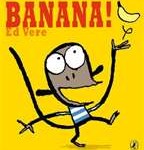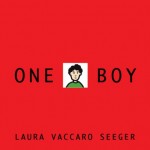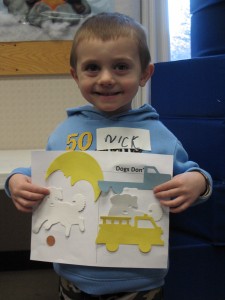Go Bananas!
 Want a book that every kid in your class can read with expression and enjoyment? Try Ed Vere’s nearly wordless picture book, Banana! I love using wordless and nearly wordless books with young readers. (If you want the myriad of reasons why wordless books are great for building narrative skills, fluency, top-down processing, etc., check out this article by the Center for the Improvement of Early Reading Achievement or this one from Education Week.) The facial expressions on the two monkeys are so engaging, and the text is limited to two words: banana and please with either question marks or exclamation points. Read it aloud once to your little ones, and they’ll be begging to read it on their own. Use it as a lesson on punctuation and how it changes the way we read words on the page. Take two monkey puppets or make monkey masks and let the kids act out the story – even better if you bring in real bananas!
Want a book that every kid in your class can read with expression and enjoyment? Try Ed Vere’s nearly wordless picture book, Banana! I love using wordless and nearly wordless books with young readers. (If you want the myriad of reasons why wordless books are great for building narrative skills, fluency, top-down processing, etc., check out this article by the Center for the Improvement of Early Reading Achievement or this one from Education Week.) The facial expressions on the two monkeys are so engaging, and the text is limited to two words: banana and please with either question marks or exclamation points. Read it aloud once to your little ones, and they’ll be begging to read it on their own. Use it as a lesson on punctuation and how it changes the way we read words on the page. Take two monkey puppets or make monkey masks and let the kids act out the story – even better if you bring in real bananas!
Dogs Don’t Brush Their Teeth
 Dogs Don’t Brush Their Teeth by Diane deGroat and Shelley Rotner is the perfect beginning reader book. The text on each page is simple: “Dogs do” or “Dogs don’t”. The pictures are photos that have been digitally manipulated to show what dogs do (like howl at the moon) and what dogs don’t do (like play an electric guitar in a rock band). Your little ones will be howling with laughter over the funny photos, and with the simple words, they’ll be successful readers the first time they pick the book up.
Dogs Don’t Brush Their Teeth by Diane deGroat and Shelley Rotner is the perfect beginning reader book. The text on each page is simple: “Dogs do” or “Dogs don’t”. The pictures are photos that have been digitally manipulated to show what dogs do (like howl at the moon) and what dogs don’t do (like play an electric guitar in a rock band). Your little ones will be howling with laughter over the funny photos, and with the simple words, they’ll be successful readers the first time they pick the book up.
We extended this book in two different ways. With our younger listeners, we had them decorate dog masks and put them on. Then we asked them to show us with their bodies what a dog can do (like nudge a ball on the floor) and what a dog can’t do (like toss and catch the ball in their hands). For a writing activity, students glued die-cuts of dogs and other objects and wrote or dictated sentences in a simple chart to show “Dogs Do” and “Dogs Don’t”. Nature Smart animal lovers and your Body Smart movers-and-shakers will love this book!
Read More“One Boy”
 With cool cut-outs on the pages, One Boy by Laura Vaccaro Seeger shows how one word can be found within another word. This counting book starts with the words “One boy” (who we see through a cut-out square on the next page.) Turn the page, and the square hole is now aligned over the word “one” to show that it’s part of the word “alone”. I made index cards of each word in the word pairs where one word shows through to be part of the other word (room and brooms, etc.) After reading One Boy to kindergartners, I gave each student a card with a word and asked them to find their “word building buddy”. Even students who were still working on letter identification could hold a card next to another to see how the letter shapes matched up. Once students had found their word building buddy, we displayed the cards next to each other and asked for a class vote of thumbs up or down on whether or not a match had been made. A counting book that also helps teach print awareness? One Boy is one good book!
With cool cut-outs on the pages, One Boy by Laura Vaccaro Seeger shows how one word can be found within another word. This counting book starts with the words “One boy” (who we see through a cut-out square on the next page.) Turn the page, and the square hole is now aligned over the word “one” to show that it’s part of the word “alone”. I made index cards of each word in the word pairs where one word shows through to be part of the other word (room and brooms, etc.) After reading One Boy to kindergartners, I gave each student a card with a word and asked them to find their “word building buddy”. Even students who were still working on letter identification could hold a card next to another to see how the letter shapes matched up. Once students had found their word building buddy, we displayed the cards next to each other and asked for a class vote of thumbs up or down on whether or not a match had been made. A counting book that also helps teach print awareness? One Boy is one good book!








